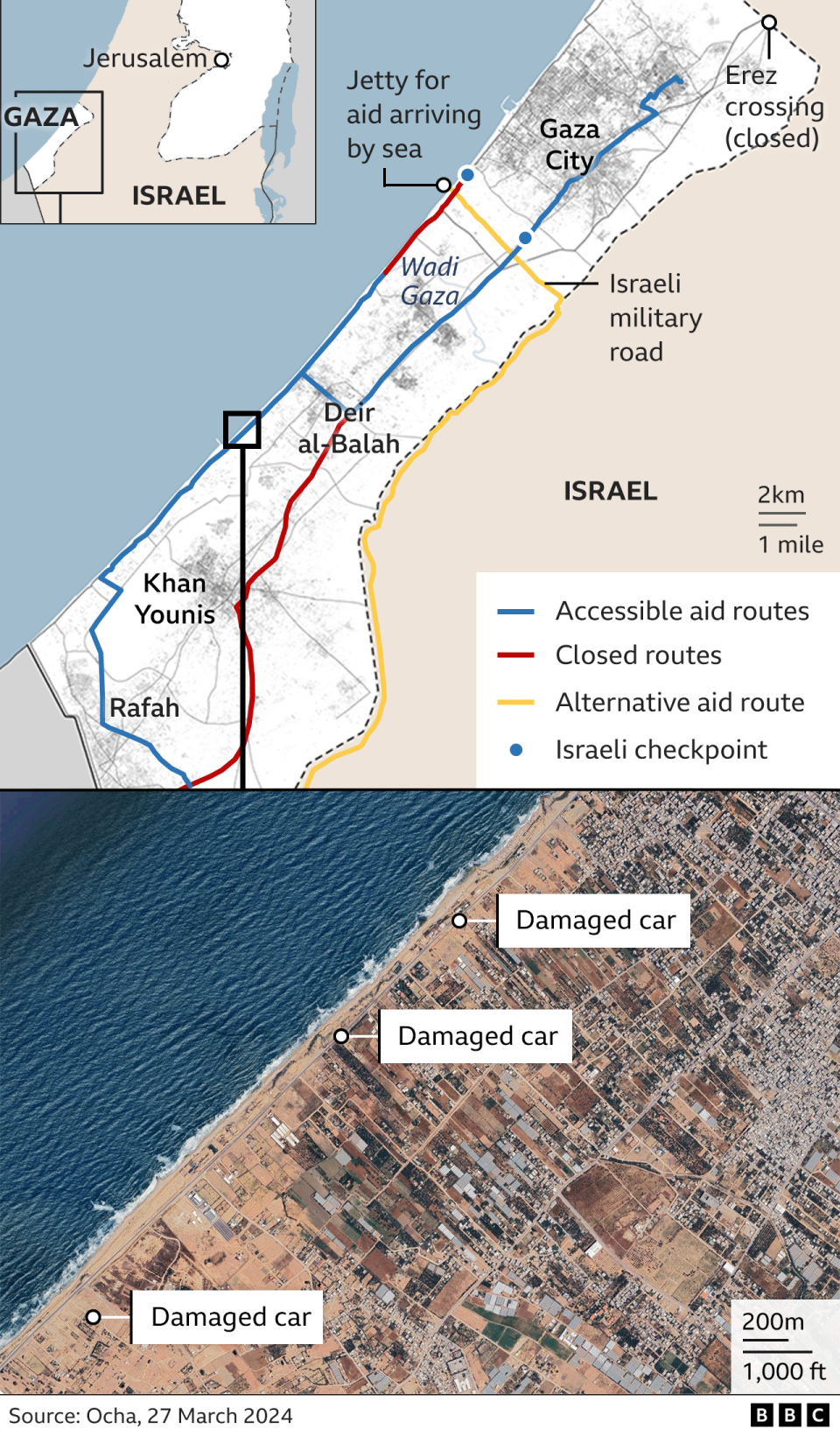Three of them were British and Foreign Secretary David Cameron has called on Israel to “urgently explain how this happened”.
BBC Verify has been studying images of the aftermath of the attack, shared on social media, to try to piece together what we know about the incident.

The convoy
The charity says the aid workers were travelling in three cars – two of them armoured.
It says the convoy’s movements had been co-ordinated with the Israel Defense Forces (IDF).
The convoy had dropped off more than 100 tonnes of food supplies at a warehouse in Deir al-Balah in central Gaza, according to the charity.
By analysing images of three heavily damaged vehicles – one of them bearing a WCK logo on the roof – BBC Verify has worked out their locations.
They are around 2.5km (1.5 miles) apart, which suggests there was more than one strike.
BBC Verify pinpointed their locations by matching visual clues in the photos of them with satellite images of this part of Gaza.
In one image of a heavily damaged Toyota Hilux, as well as the trees and fence beside the vehicle, a lone palm tree stands in a walled enclosure with a distinctive pattern of buildings surrounding it.
Using satellite images, these features have been matched with a part of Al-Rashid road – which runs along the coast in central Gaza.


In a photo of a second badly damaged vehicle, a large jagged hole can been seen in the roof of a different Toyota Hilux. A WCK logo is also visible.
Elsewhere, a pylon, a section of woodland, a low wall and two distinct roofs can be seen in the background. BBC Verify has matched the scene to about 800m south of the first vehicle.


A third damaged vehicle was photographed in an area of open ground to the south, about 100m off the road.
The WCK says this third car was a “soft-skin vehicle” – meaning not armoured. It was about 1.6km south of the second vehicle and 2.5km of the first.


“It was a direct hit. They tried to treat some of them and put them in another car in front. But they shelled the car,” said a local resident, who said he had witnessed the strike.
In an interview with Reuters on Wednesday, WCK founder Jose Andres said the charity had clear communication with the Israeli military.
“This was not just a bad luck situation where ‘oops’ we dropped the bomb in the wrong place,” he said.
What weapons might have been used?
BBC Verify showed images of the cars to a number of weapons experts.
They do not show fragments of missiles or bombs at the scene but the experts studied the damage to the vehicles.
Chris Cobb-Smith, a former British Army officer and ex-UN weapons inspector, said the attack was probably the result of drone-launched Spike missiles.
Spike missiles are a type of powerful weapon, usually launched against tanks and other armoured vehicles.
Justin Crump, a former British Army officer who runs Sibylline – a risk intelligence company – agreed. He says the attack “was likely drone-launched and targeted”.
He added the strike had probably been caused by a missile, rather than a bomb or mortar.
The victims
The seven aid workers killed have been named by WCK as:
-
Lalzawmi “Zomi” Frankcom, 43, an Australian citizen
-
Damian Sobol, 35, a Polish citizen
-
Saifeddin Issam Ayad Abutaha, 25, a Palestinian
-
Jacob Flickinger, 33, a dual US-Canadian national
-
John Chapman, 57, a British citizen
-
James (Jim) Henderson, 33, a British citizen
-
James Kirby, 47, a British citizen


Images of the aid workers’ bodies were first posted on social media just before 22:30 BST on 1 April.
Graphic videos showed the bodies of five individuals. Two more bodies were recovered from Deir al-Balah later on, the Palestine Red Crescent Society said on X.
WCK logos were visible on bulletproof vests on at least three of the deceased.
Videos also showed colleagues from WCK identifying the bodies.
“These are the people who brought the aid from the sea,” one said, before crying out as he recognised a Palestinian aid worker killed.
The route
WCK said the food supplies had been brought to Gaza “on the maritime route”.
Aid is delivered by sea using a jetty recently constructed by WCK west of Gaza city. The first delivery via the route was on 15 March.
WCK also has a “Welcome Centre” along the coastal road for refugees fleeing the north.
It is unclear exactly where the Deir al-Balah warehouse is, but WCK recently opened a new field kitchen to the east of Deir al Balah, off Salah al-Din road.
A video shared to their X account last week shows a storage area with a forklift truck as well as food on pallets. This location is roughly 5km from where the first car was struck on the coastal road.
BBC Verify asked the food aid charity for the warehouse location and details of the co-ordinates they shared with Israeli forces but they did not provide any details.
The IDF chief of general staff Herzi Halevi has issued a statement calling the attack “a mistake that followed a misidentification at night… it shouldn’t have happened”.
He said an investigation into the incident would be completed “in the next coming days”.
BBC Verify is continuing to investigate this incident.
Additional reporting by Merlyn Thomas, Osob Elmi and Joshua Cheetham


What do you want BBC Verify to investigate?
